二叉树操作的实现
二叉树的基本操作课件浙教版(2019)高中信息技术选修1(24张PPT)

A
B
D
C
E
F
G
头指针
二叉树的list实现
二叉树节点可以看成是一个三元组,元素是左、右子树和本节点数据。
Python的list可以用于组合这样的三个元素。
下面介绍用list构造二叉树的方法。
(1)空树用None表示。
(2)非空二叉树用包含三个元素的列表[d,l,r]表示,其中:d表示根节点的元素,l和r是两棵子树,采用与整个二叉树同样结构的list表示。
二叉树的遍历
在完成二叉树的建立操作后,就可以对二叉树的各个节点进行访问,即遍历操作。二叉树的遍历,是指按照一定的规则和次序访问二叉树中的所有节点,使得每个节点都被访问一次且仅被访问一次。按照不同的遍历方式对节点进行访问,其处理效率不完全相同。二叉树的遍历方式有很多,主要有前序遍历、中序遍历和后序遍历等。
1.数组实现
用数组来表示二叉树时,分为以下两种情况。
(1)完全二叉树从二叉树的根节点开始,按从上而下、自左向右的顺序对n个节点进行编号,根节点的编号为0,最后一个节点的编号为n-1。然后依次将二叉树的节点用一组连续的数组元素来表示,节点编号与数组的下标一一对应。如下图中图甲所示的完全二叉树所对应的一维数组表示如图乙所示。
A
B
C
A
B
C
甲 原二叉树
乙 补全后的二叉树
0
1
2
3
4
5
6
7
丙 数组实现示意图
A
B
C
对于完全二叉树而言,一维数组的表示方式既简单又节省存储空间。但对于一般的二叉树来说,采用一维数组表示时,结构虽然简单,却容易造成存储空间的浪费。
(完整版)C++二叉树基本操作实验报告
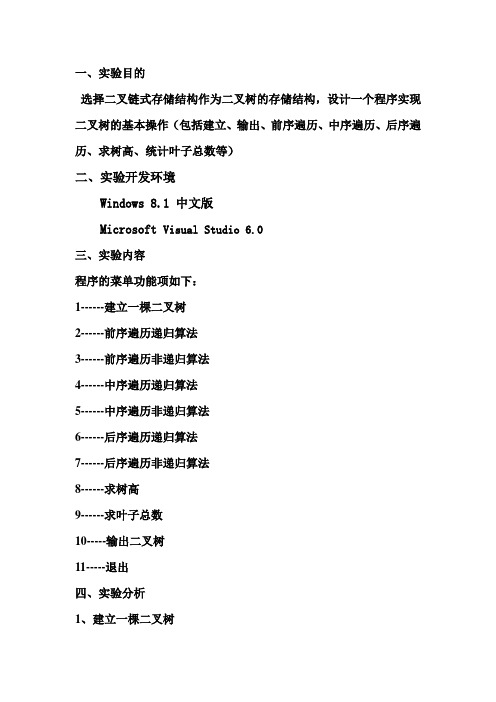
一、实验目的选择二叉链式存储结构作为二叉树的存储结构,设计一个程序实现二叉树的基本操作(包括建立、输出、前序遍历、中序遍历、后序遍历、求树高、统计叶子总数等)二、实验开发环境Windows 8.1 中文版Microsoft Visual Studio 6.0三、实验内容程序的菜单功能项如下:1------建立一棵二叉树2------前序遍历递归算法3------前序遍历非递归算法4------中序遍历递归算法5------中序遍历非递归算法6------后序遍历递归算法7------后序遍历非递归算法8------求树高9------求叶子总数10-----输出二叉树11-----退出四、实验分析1、建立一棵二叉树2、输入二叉树各节点数据cout<<"请按正确顺序输入二叉树的数据:";cin.getline(t,1000); //先把输入的数据输入到一个t数组3、递归前序遍历void BL1(ECS_data *t){if(NULL!=t){cout<<t->data<<",";BL1(t->l);BL1(t->r);}}4、非递归前序遍历void preOrder2(ECS_data *t){stack<ECS_data*> s;ECS_data *p=t;while(p!=NULL||!s.empty()){while(p!=NULL){cout<<p->data<<" ";s.push(p);p=p->l;}if(!s.empty()){p=s.top();s.pop();p=p->r;}}}5、递归中序遍历void BL2(ECS_data *t){if(NULL!=t){BL2(t->l);cout<<t->data<<",";BL2(t->r);}}6、非递归中序遍历void inOrder2(ECS_data *t) //非递归中序遍历{stack<ECS_data*> s;ECS_data *p=t;while(p!=NULL||!s.empty()){while(p!=NULL){s.push(p);p=p->l;}if(!s.empty()){p=s.top();cout<<p->data<<" ";s.pop();p=p->r;}}}7、递归后序遍历void BL3(ECS_data *t){if(NULL!=t){BL3(t->l);BL3(t->r);cout<<t->data<<",";}}8、非递归后序遍历void postOrder3(ECS_data *t){stack<ECS_data*> s;ECS_data *cur; //当前结点ECS_data *pre=NULL; //前一次访问的结点s.push(t);while(!s.empty()){cur=s.top();if((cur->l==NULL&&cur->r==NULL)||(pre!=NULL&&(pre==cur->l||pre==cur->r))){cout<<cur->data<<" "; //如果当前结点没有孩子结点或者孩子节点都已被访问过s.pop();pre=cur;}else{if(cur->r!=NULL)s.push(cur->r);if(cur->l!=NULL)s.push(cur->l);}}}9、求树高int Height (ECS_data *t){if(t==NULL) return 0;else{int m = Height ( t->l );int n = Height(t->r);return (m > n) ? (m+1) : (n+1);}}10、求叶子总数int CountLeaf(ECS_data *t){static int LeafNum=0;//叶子初始数目为0,使用静态变量if(t)//树非空{if(t->l==NULL&&t->r==NULL)//为叶子结点LeafNum++;//叶子数目加1else//不为叶子结点{CountLeaf(t->l);//递归统计左子树叶子数目CountLeaf(t->r);//递归统计右子树叶子数目}}return LeafNum;}五、运行结果附:完整程序源代码://二叉树链式存储的实现#include<iostream>#include<cstring>#include <stack>using namespace std;struct ECS_data //先定义好一个数据的结构{char data;ECS_data *l;ECS_data *r;};class ECS{private://int level; //树高int n; //表示有多少个节点数int n1; //表示的是数组的总长度值,(包括#),因为后面要进行删除判断ECS_data *temp[1000];public:ECS_data *root;ECS() //初始化{ECS_data *p;char t[1000];int i;int front=0,rear=1; //front表示有多少个节点,rear表示当前插入的点的父母cout<<"请按正确顺序输入二叉树的数据:";cin.getline(t,1000); //先把输入的数据输入到一个t数组//cout<<t<<" "<<endl;int n1=strlen(t); //测量数据的长度n=0;for(i=0;i<n1;i++){if(t[i]!='#'){p=NULL;if(t[i]!=',') //满足条件并开辟内存{n++;p=new ECS_data;p->data=t[i];p->l=NULL;p->r=NULL;}front++;temp[front]=p;if(1 == front){root=p;}else{if((p!=NULL)&&(0==front%2)){temp[rear]->l=p;//刚开始把这里写成了==}if((p!=NULL)&&(1==front%2)){temp[rear]->r=p;}if(1==front%2)rear++; //就当前的数据找这个数据的父母}}}}~ECS() //释放内存{int i;for(i=1;i<=n;i++)if(temp[i]!=NULL)delete temp[i];}void JS() //记录节点的个数{int s;s=n;cout<<"该二叉树的节点数为:"<<s<<endl;}void BL1(ECS_data *t)//递归前序遍历{if(NULL!=t){cout<<t->data<<",";BL1(t->l);BL1(t->r);}}void preOrder2(ECS_data *t) //非递归前序遍历{stack<ECS_data*> s;ECS_data *p=t;while(p!=NULL||!s.empty()){while(p!=NULL){cout<<p->data<<" ";s.push(p);p=p->l;}if(!s.empty()){p=s.top();s.pop();p=p->r;}}}void BL2(ECS_data *t)//递归中序遍历{if(NULL!=t){BL2(t->l);cout<<t->data<<",";BL2(t->r);}}void inOrder2(ECS_data *t) //非递归中序遍历{stack<ECS_data*> s;ECS_data *p=t;while(p!=NULL||!s.empty()){while(p!=NULL){s.push(p);p=p->l;}if(!s.empty()){p=s.top();cout<<p->data<<" ";s.pop();p=p->r;}}}void BL3(ECS_data *t)//递归后序遍历{if(NULL!=t){BL3(t->l);BL3(t->r);cout<<t->data<<",";}}void postOrder3(ECS_data *t) //非递归后序遍历{stack<ECS_data*> s;ECS_data *cur; //当前结点ECS_data *pre=NULL; //前一次访问的结点s.push(t);while(!s.empty()){cur=s.top();if((cur->l==NULL&&cur->r==NULL)||(pre!=NULL&&(pre==cur->l||pre==cur->r))){cout<<cur->data<<" "; //如果当前结点没有孩子结点或者孩子节点都已被访问过s.pop();pre=cur;}else{if(cur->r!=NULL)s.push(cur->r);if(cur->l!=NULL)s.push(cur->l);}}}int Height (ECS_data *t) //求树高{if(t==NULL) return 0;else{int m = Height ( t->l );int n = Height(t->r);return (m > n) ? (m+1) : (n+1);}}int CountLeaf(ECS_data *t) //求叶子总数{static int LeafNum=0;//叶子初始数目为0,使用静态变量if(t)//树非空{if(t->l==NULL&&t->r==NULL)//为叶子结点LeafNum++;//叶子数目加1else//不为叶子结点{CountLeaf(t->l);//递归统计左子树叶子数目CountLeaf(t->r);//递归统计右子树叶子数目}}return LeafNum;}};int main(){ECS a;a.JS();cout<<"递归前序遍历:";a.BL1(a.root);cout<<endl;cout<<"非递归前序遍历:";a.preOrder2(a.root);cout<<endl;cout<<"递归中序遍历:";a.BL2(a.root);cout<<endl;cout<<"非递归中序遍历:";a.inOrder2(a.root);cout<<endl;cout<<"递归后序遍历:";a.BL3(a.root);cout<<endl;cout<<"非递归后序遍历:";a.postOrder3(a.root);cout<<endl;cout<<"树高为:"<<a.Height(a.root)<<endl;cout<<"叶子总数为:"<<a.CountLeaf(a.root)<<endl;return 0;}。
c语言实现二叉树的四种遍历和求深度与叶子个数

c语言实现二叉树的四种遍历和求深度与叶子个数二叉树是一种常见的数据结构,它由节点组成,每个节点最多有两个子节点。
在C语言中,我们可以使用指针来实现二叉树的操作。
本文将介绍四种常见的二叉树遍历方式,以及如何求解二叉树的深度和叶子节点个数。
首先,我们需要定义一个二叉树节点的结构体,包含一个数据域和两个指针域,分别指向左子节点和右子节点。
代码如下:```cstruct TreeNode {int data;struct TreeNode* left;struct TreeNode* right;};```接下来,我们可以实现二叉树的四种遍历方式:前序遍历、中序遍历、后序遍历和层序遍历。
前序遍历是指先访问根节点,然后递归地遍历左子树和右子树。
代码如下:```cvoid preorderTraversal(struct TreeNode* root) {if (root == NULL) {return;}printf("%d ", root->data);preorderTraversal(root->left);preorderTraversal(root->right);}```中序遍历是指先递归地遍历左子树,然后访问根节点,最后递归地遍历右子树。
代码如下:```cvoid inorderTraversal(struct TreeNode* root) {if (root == NULL) {return;}inorderTraversal(root->left);printf("%d ", root->data);inorderTraversal(root->right);}```后序遍历是指先递归地遍历左子树和右子树,最后访问根节点。
代码如下:```cvoid postorderTraversal(struct TreeNode* root) {if (root == NULL) {return;}postorderTraversal(root->left);postorderTraversal(root->right);printf("%d ", root->data);}```层序遍历是按照树的层次逐层遍历节点。
二叉树的各种基本运算的实现实验报告

二叉树的各种基本运算的实现实验报告
一、实验目的
实验目的为了深入学习二叉树的各种基本运算,通过操作实现二叉树的建立、存储、查找、删除、遍历等各种基本运算操作。
二、实验内容
1、构造一个二叉树。
我们首先用一定的节点来构建一棵二叉树,包括节点的左子节点和右子节点。
2、实现查找二叉树中的节点。
在查找二叉树中的节点时,我们根据二叉树的特点,从根节点开始查找,根据要查找的节点的值与根节点的值的大小的关系,来决定接下来查找的方向,直到找到要查找的节点为止。
3、实现删除二叉树中的节点。
在删除二叉树节点时,我们要做的是找到要删除节点的父节点,然后让父节点的链接指向要删除节点的子节点,有可能要删除节点有一个子节点,有可能有两个极点,有可能没有子节点,我们要根据每种情况进行处理,来保持二叉树的结构不变。
4、对二叉树进行遍历操作。
二叉树的遍历有多种方法,本实验使用的是先序遍历。
首先从根节点出发,根据先序遍历的顺序,先访问左子树,然后再访问右子树,最后访问根节点。
三、实验步骤
1、构建二叉树:
我们用一个数组代表要构建的二叉树,第一项为根节点,第二项和第三项是根节点的子节点。
实验六二叉树实验报告

实验四二叉树的操作班级:计算机1002班姓名:唐自鸿学号:201003010207 完成日期:2010.6.14 题目:对于给定的一二叉树,实现各种约定的遍历。
一、实验目的:(1)掌握二叉树的定义和存储表示,学会建立一棵特定二叉树的方法;(2)掌握二叉树的遍历算法(先序、中序、后序遍历算法)的思想,并学会遍历算法的递归实现和非递归实现。
二、实验内容:构造二叉树,再实现二叉树的先序、中序、后序遍历,最后统计二叉树的深度。
三、实验步骤:(一) 需求分析1. 二叉树的建立首先要建立一个二叉链表的结构体,包含根节点和左右子树。
因为树的每一个左右子树又是一颗二叉树,所以用递归的方法来建立其左右子树。
二叉树的遍历是一种把二叉树的每一个节点访问并输出的过程,遍历时根结点与左右孩子的输出顺序构成了不同的遍历方法,这个过程需要按照不同的遍历的方法,先输出根结点还是先输出左右孩子,可以用选择语句来实现。
2.程序的执行命令为:1)构造结点类型,然后创建二叉树。
2)根据提示,从键盘输入各个结点。
3)通过选择一种方式(先序、中序或者后序)遍历。
4)输出结果,结束。
(二)概要设计1.二叉树的二叉链表结点存储类型定义typedef struct Node{DataType data;struct Node *LChild;struct Node *RChild;}BitNode,*BitTree;2.建立如下图所示二叉树:void CreatBiTree(BitTree *bt)用扩展先序遍历序列创建二叉树,如果是当前树根置为空,否则申请一个新节点。
3.本程序包含四个模块1) 主程序模块:2)先序遍历模块3)中序遍历模块4)后序遍历模块4.模块调用关系:主程序模块(三)详细设计1.建立二叉树存储类型//==========构造二叉树=======void CreatBiTree(BitTree *bt)//用扩展先序遍历序列创建二叉树,如果是当前树根置为空,否则申请一个新节点//{char ch;ch=getchar();if(ch=='.')*bt=NULL;else{*bt=(BitTree)malloc(sizeof(BitNode));//申请一段关于该节点类型的存储空间(*bt)->data=ch; //生成根结点CreatBiTree(&((*bt)->LChild)); //构造左子树CreatBiTree(&((*bt)->RChild)); //构造右子树}}2. 编程实现以上二叉树的前序、中序和后序遍历操作,输出遍历序列1)先序遍历二叉树的递归算法如下:void PreOrder(BitTree root){if (root!=NULL){Visit(root ->data);PreOrder(root ->LChild); //递归调用核心PreOrder(root ->RChild);}}2)中序遍历二叉树的递归算法如下:void InOrder(BitTree root){if (root!=NULL){InOrder(root ->LChild);Visit(root ->data);InOrder(root ->RChild);}}3)后序遍历二叉树的递归算法如下:void PostOrder(BitTree root){if(root!=NULL){PostOrder(root ->LChild);PostOrder(root ->RChild);Visit(root ->data);}}4)计算二叉树的深度算法如下:int PostTreeDepth(BitTree bt) //求二叉树的深度{int hl,hr,max;if(bt!=NULL){hl=PostTreeDepth(bt->LChild); //求左子树的深度hr=PostTreeDepth(bt->RChild); //求右子树的深度max=hl>hr?hl:hr; //得到左、右子树深度较大者return(max+1); //返回树的深度}else return(0); //如果是空树,则返回0}四、调试分析及测试结果1. 进入演示程序后的显示主界面:请输入二叉树中的元素;先序、中序和后序遍历分别输出结果。
二叉树实验报告
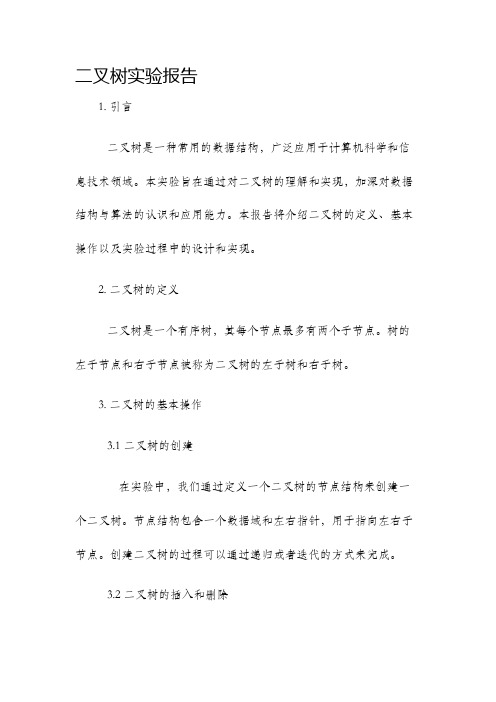
二叉树实验报告1. 引言二叉树是一种常用的数据结构,广泛应用于计算机科学和信息技术领域。
本实验旨在通过对二叉树的理解和实现,加深对数据结构与算法的认识和应用能力。
本报告将介绍二叉树的定义、基本操作以及实验过程中的设计和实现。
2. 二叉树的定义二叉树是一个有序树,其每个节点最多有两个子节点。
树的左子节点和右子节点被称为二叉树的左子树和右子树。
3. 二叉树的基本操作3.1 二叉树的创建在实验中,我们通过定义一个二叉树的节点结构来创建一个二叉树。
节点结构包含一个数据域和左右指针,用于指向左右子节点。
创建二叉树的过程可以通过递归或者迭代的方式来完成。
3.2 二叉树的插入和删除二叉树的插入操作是将新节点插入到树中的合适位置。
插入时需要考虑保持二叉树的有序性。
删除操作是将指定节点从树中删除,并保持二叉树的有序性。
在实验中,我们可以使用递归或者循环的方式实现这些操作。
3.3 二叉树的遍历二叉树的遍历是指按照某种次序访问二叉树的所有节点。
常见的遍历方式包括前序遍历、中序遍历和后序遍历。
前序遍历先访问根节点,然后按照左孩子-右孩子的顺序递归遍历左右子树。
中序遍历按照左孩子-根节点-右孩子的顺序递归遍历左右子树。
后序遍历按照左孩子-右孩子-根节点的顺序递归遍历左右子树。
3.4 二叉树的查找查找操作是指在二叉树中查找指定的值。
可以通过递归或者循环的方式实现二叉树的查找操作。
基本思路是从根节点开始,通过比较节点的值和目标值的大小关系,逐步向左子树或者右子树进行查找,直到找到目标节点或者遍历到叶子节点。
4. 实验设计和实现在本实验中,我们设计并实现了一个基于Python语言的二叉树类。
具体实现包括二叉树的创建、插入、删除、遍历和查找操作。
在实验过程中,我们运用了递归和迭代的方法实现了这些操作,并进行了测试和验证。
4.1 二叉树类的设计我们将二叉树的节点设计为一个类,其中包括数据域和左右子节点的指针。
另外,我们设计了一个二叉树类,包含了二叉树的基本操作方法。
二叉树的基本操作与实现实验报告

二叉树的基本操作与实现实验报告二叉树是一种重要的数据结构,在计算机科学领域中被广泛应用。
本实验将介绍二叉树的基本操作与实现,并给出相应的实验报告。
一、引言二叉树是一种特殊的树状结构,每个节点至多有两个子节点。
二叉树有许多重要的特性,如平衡二叉树、二叉树等,应用广泛。
在本实验中,我们将介绍二叉树的基本操作和实现。
二、实验目的1.掌握二叉树的基本概念和特性;2.熟悉二叉树的基本操作,包括创建、插入、删除、遍历等;3.学会使用编程语言实现二叉树的基本操作。
三、实验内容本实验主要包括以下内容:1.二叉树的定义和基本概念;2.二叉树的基本操作,包括创建、插入、删除、遍历等;3.使用编程语言实现二叉树的基本操作;4.测试和验证二叉树的基本操作的正确性。
四、实验步骤1.二叉树的定义和基本概念二叉树是一种树状结构,每个节点至多有两个子节点。
二叉树的每个节点包含一个数据项和指向左子树和右子树的指针。
二叉树的特性有很多,如完全二叉树、平衡二叉树、二叉树等。
2.二叉树的基本操作(1)创建二叉树:可以通过手动输入节点数据来创建二叉树,也可以通过读取文件中的数据来创建二叉树。
(2)插入节点:在指定位置插入一个新节点。
(3)删除节点:删除指定位置的节点。
(4)遍历二叉树:有前序遍历、中序遍历和后序遍历三种遍历方式。
3.使用编程语言实现二叉树的基本操作实现二叉树的基本操作可以使用编程语言来完成。
我们可以定义一个二叉树的结构体,包含节点数据和指向左右子树的指针。
然后根据具体的需求,实现相应的操作函数。
4.测试和验证二叉树的基本操作的正确性在完成二叉树的基本操作后,我们可以编写测试代码来验证操作的正确性。
通过创建二叉树,并进行插入、删除和遍历操作,观察输出结果是否符合预期。
五、实验结果与分析在完成二叉树的基本操作后,我们可以进行测试和验证。
通过输出二叉树的遍历结果,比对预期结果来判断操作是否正确。
同时,我们还可以观察二叉树的结构和特性,如是否满足平衡二叉树或二叉树的条件。
二叉树的基本操作实验报告
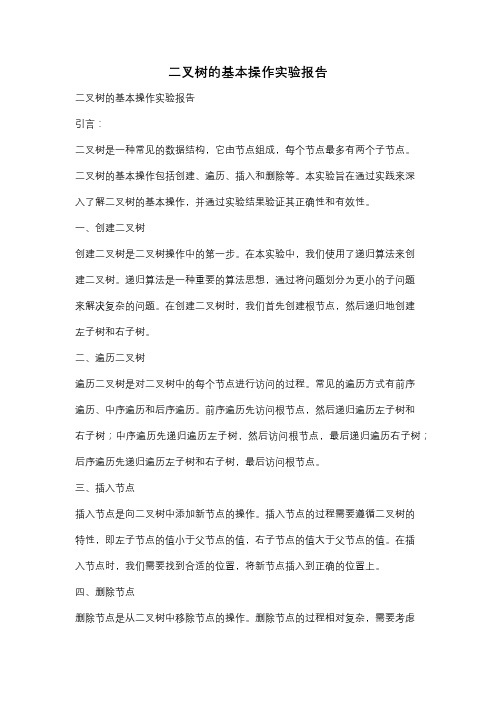
二叉树的基本操作实验报告二叉树的基本操作实验报告引言:二叉树是一种常见的数据结构,它由节点组成,每个节点最多有两个子节点。
二叉树的基本操作包括创建、遍历、插入和删除等。
本实验旨在通过实践来深入了解二叉树的基本操作,并通过实验结果验证其正确性和有效性。
一、创建二叉树创建二叉树是二叉树操作中的第一步。
在本实验中,我们使用了递归算法来创建二叉树。
递归算法是一种重要的算法思想,通过将问题划分为更小的子问题来解决复杂的问题。
在创建二叉树时,我们首先创建根节点,然后递归地创建左子树和右子树。
二、遍历二叉树遍历二叉树是对二叉树中的每个节点进行访问的过程。
常见的遍历方式有前序遍历、中序遍历和后序遍历。
前序遍历先访问根节点,然后递归遍历左子树和右子树;中序遍历先递归遍历左子树,然后访问根节点,最后递归遍历右子树;后序遍历先递归遍历左子树和右子树,最后访问根节点。
三、插入节点插入节点是向二叉树中添加新节点的操作。
插入节点的过程需要遵循二叉树的特性,即左子节点的值小于父节点的值,右子节点的值大于父节点的值。
在插入节点时,我们需要找到合适的位置,将新节点插入到正确的位置上。
四、删除节点删除节点是从二叉树中移除节点的操作。
删除节点的过程相对复杂,需要考虑多种情况。
如果要删除的节点是叶子节点,直接删除即可。
如果要删除的节点只有一个子节点,将其子节点连接到父节点上。
如果要删除的节点有两个子节点,我们需要找到其后继节点或前驱节点来替代被删除的节点。
实验结果:通过实验,我们成功地实现了二叉树的基本操作。
创建二叉树的递归算法能够正确地创建出符合要求的二叉树。
遍历二叉树的算法能够按照指定的顺序遍历每个节点。
插入节点和删除节点的操作也能够正确地修改二叉树的结构。
讨论与总结:二叉树的基本操作是数据结构中的重要内容,对于理解和应用其他数据结构具有重要意义。
通过本次实验,我们深入了解了二叉树的创建、遍历、插入和删除等操作,并通过实验验证了其正确性和有效性。
java实现二叉树的基本操作
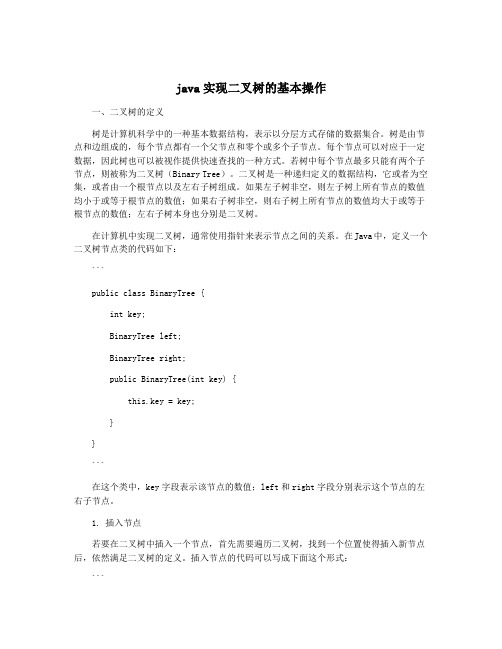
java实现二叉树的基本操作一、二叉树的定义树是计算机科学中的一种基本数据结构,表示以分层方式存储的数据集合。
树是由节点和边组成的,每个节点都有一个父节点和零个或多个子节点。
每个节点可以对应于一定数据,因此树也可以被视作提供快速查找的一种方式。
若树中每个节点最多只能有两个子节点,则被称为二叉树(Binary Tree)。
二叉树是一种递归定义的数据结构,它或者为空集,或者由一个根节点以及左右子树组成。
如果左子树非空,则左子树上所有节点的数值均小于或等于根节点的数值;如果右子树非空,则右子树上所有节点的数值均大于或等于根节点的数值;左右子树本身也分别是二叉树。
在计算机中实现二叉树,通常使用指针来表示节点之间的关系。
在Java中,定义一个二叉树节点类的代码如下:```public class BinaryTree {int key;BinaryTree left;BinaryTree right;public BinaryTree(int key) {this.key = key;}}```在这个类中,key字段表示该节点的数值;left和right字段分别表示这个节点的左右子节点。
1. 插入节点若要在二叉树中插入一个节点,首先需要遍历二叉树,找到一个位置使得插入新节点后,依然满足二叉树的定义。
插入节点的代码可以写成下面这个形式:```public void insert(int key) {BinaryTree node = new BinaryTree(key); if (root == null) {root = node;return;}BinaryTree temp = root;while (true) {if (key < temp.key) {if (temp.left == null) {temp.left = node;break;}temp = temp.left;} else {if (temp.right == null) {temp.right = node;break;}temp = temp.right;}}}```上面的代码首先创建了一个新的二叉树节点,然后判断二叉树根是否为空,若为空,则将这个节点作为根节点。
二叉树基本运算算法的实现
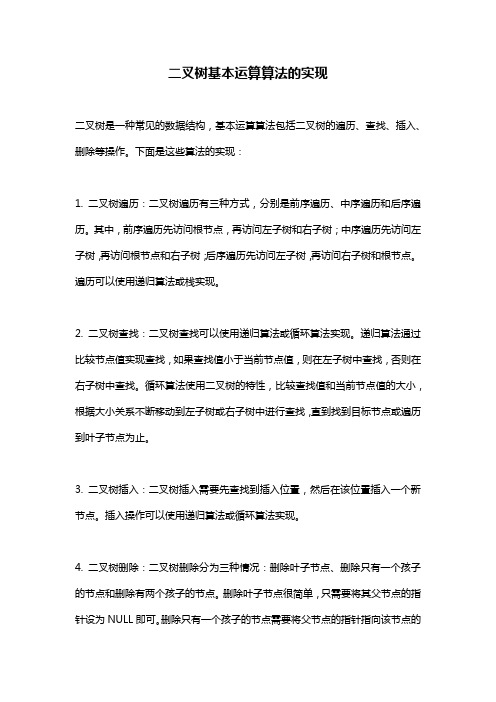
二叉树基本运算算法的实现
二叉树是一种常见的数据结构,基本运算算法包括二叉树的遍历、查找、插入、删除等操作。
下面是这些算法的实现:
1. 二叉树遍历:二叉树遍历有三种方式,分别是前序遍历、中序遍历和后序遍历。
其中,前序遍历先访问根节点,再访问左子树和右子树;中序遍历先访问左子树,再访问根节点和右子树;后序遍历先访问左子树,再访问右子树和根节点。
遍历可以使用递归算法或栈实现。
2. 二叉树查找:二叉树查找可以使用递归算法或循环算法实现。
递归算法通过比较节点值实现查找,如果查找值小于当前节点值,则在左子树中查找,否则在右子树中查找。
循环算法使用二叉树的特性,比较查找值和当前节点值的大小,根据大小关系不断移动到左子树或右子树中进行查找,直到找到目标节点或遍历到叶子节点为止。
3. 二叉树插入:二叉树插入需要先查找到插入位置,然后在该位置插入一个新节点。
插入操作可以使用递归算法或循环算法实现。
4. 二叉树删除:二叉树删除分为三种情况:删除叶子节点、删除只有一个孩子的节点和删除有两个孩子的节点。
删除叶子节点很简单,只需要将其父节点的指针设为NULL即可。
删除只有一个孩子的节点需要将父节点的指针指向该节点的
孩子节点。
删除有两个孩子的节点需要找到该节点的后继节点(或前驱节点),将后继节点的值复制到该节点中,然后删除后继节点。
上述算法的实现需要根据具体的编程语言进行调整和实现。
数据结构实验报告-二叉树的实现与遍历
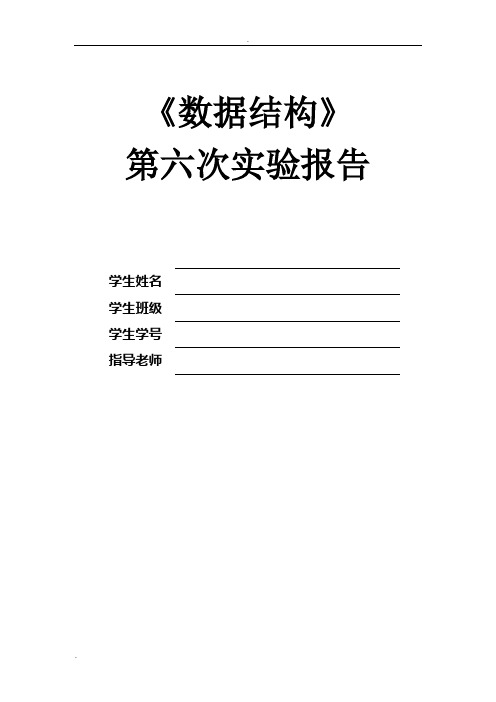
《数据结构》第六次实验报告学生姓名学生班级学生学号指导老师一、实验内容1) 采用二叉树链表作为存储结构,完成二叉树的建立,先序、中序和后序以及按层次遍历的操作,求所有叶子及结点总数的操作。
2) 输出树的深度,最大元,最小元。
二、需求分析遍历二叉树首先有三种方法,即先序遍历,中序遍历和后序遍历。
递归方法比较简单,首先获得结点指针如果指针不为空,且有左子,从左子递归到下一层,如果没有左子,从右子递归到下一层,如果指针为空,则结束一层递归调用。
直到递归全部结束。
下面重点来讲述非递归方法:首先介绍先序遍历:先序遍历的顺序是根左右,也就是说先访问根结点然后访问其左子再然后访问其右子。
具体算法实现如下:如果结点的指针不为空,结点指针入栈,输出相应结点的数据,同时指针指向其左子,如果结点的指针为空,表示左子树访问结束,栈顶结点指针出栈,指针指向其右子,对其右子树进行访问,如此循环,直至结点指针和栈均为空时,遍历结束。
再次介绍中序遍历:中序遍历的顺序是左根右,中序遍历和先序遍历思想差不多,只是打印顺序稍有变化。
具体实现算法如下:如果结点指针不为空,结点入栈,指针指向其左子,如果指针为空,表示左子树访问完成,则栈顶结点指针出栈,并输出相应结点的数据,同时指针指向其右子,对其右子树进行访问。
如此循环直至结点指针和栈均为空,遍历结束。
最后介绍后序遍历:后序遍历的顺序是左右根,后序遍历是比较难的一种,首先需要建立两个栈,一个用来存放结点的指针,另一个存放标志位,也是首先访问根结点,如果结点的指针不为空,根结点入栈,与之对应的标志位也随之入标志位栈,并赋值0,表示该结点的右子还没有访问,指针指向该结点的左子,如果结点指针为空,表示左子访问完成,父结点出栈,与之对应的标志位也随之出栈,如果相应的标志位值为0,表示右子树还没有访问,指针指向其右子,父结点再次入栈,与之对应的标志位也入栈,但要给标志位赋值为1,表示右子访问过。
二叉树实现及应用实验报告

二叉树实现及应用实验报告实验名称:二叉树实现及应用实验目的:1. 实现二叉树的创建、插入和删除操作。
2. 学习二叉树的遍历方法,并能够应用于实际问题。
3. 掌握二叉树在数据结构和算法中的一些常用应用。
实验内容:1. 实现二叉树的创建、插入和删除操作,包括二叉树的构造函数、插入函数和删除函数。
2. 学习二叉树的三种遍历方法:前序遍历、中序遍历和后序遍历,并应用于实际问题。
3. 掌握二叉树的一些常用应用,如二叉搜索树、平衡二叉树和哈夫曼树等。
实验步骤:1. 创建二叉树的结构体,包括树节点和树的根节点。
2. 实现二叉树的构造函数,用于创建二叉树的根节点。
3. 实现二叉树的插入函数,用于将元素插入到二叉树中的合适位置。
4. 实现二叉树的删除函数,用于删除二叉树中的指定元素。
5. 学习并实现二叉树的前序遍历、中序遍历和后序遍历函数。
6. 运用二叉树的遍历方法解决实际问题,如查找二叉树中的最大值和最小值。
7. 学习并应用二叉搜索树、平衡二叉树和哈夫曼树等常用二叉树结构。
实验结果:1. 成功创建、插入和删除二叉树中的元素,实现了二叉树的基本操作。
2. 正确实现了二叉树的前序遍历、中序遍历和后序遍历,并能够正确输出遍历结果。
3. 通过二叉树的遍历方法成功解决了实际问题,如查找二叉树中的最大值和最小值。
4. 学习并熟练应用了二叉搜索树、平衡二叉树和哈夫曼树等常用二叉树结构,丰富了对二叉树的理解。
实验分析:1. 二叉树是一种重要的数据结构,具有较好的数据存储和查找性能,广泛应用于计算机科学和算法领域。
2. 通过实验,我们深入了解了二叉树的创建、插入和删除操作,以及前序遍历、中序遍历和后序遍历的原理和应用。
3. 实际问题往往可以转化为二叉树的遍历问题进行求解,通过实验,我们成功应用了二叉树的遍历方法解决了实际问题。
4. 熟练掌握二叉搜索树、平衡二叉树和哈夫曼树的原理和应用,对于提高我们在数据结构和算法方面的设计能力具有重要意义。
实验五 二叉树基本操作的编程实现

实验五二叉树基本操作的编程实现【实验目的】内容:二叉树基本操作的编程实现要求:二叉树基本操作的编程实现(2学时,验证型),掌握二叉树的建立、遍历、插入、删除等基本操作的编程实现,也可以进一步编程实现查找等操作,存储结构主要采用顺序或链接结构。
也鼓励学生利用基本操作进行一些应用的程序设计。
【实验性质】验证性实验(学时数:2H)【实验内容】以下的选题都可以作为本次实验的推荐题目1.建立二叉树,并以前序遍历的方式将结点内容输出。
2.将一个表示二叉树的数组结构转换成链表结构。
3.将表达式二叉树方式存入数组,以递归方式建立表达式之二叉树状结构,再分别输出前序、中序及后序遍历结果,并计算出表达式之结果。
【思考问题】1.二叉树是树吗?它的定义为什么是递归的?2.三种根序遍历主要思路是什么?3.如果不用遍历算法一般启用什么数据结构实现后序遍历?4.举出二叉树的应用范例?【参考代码】(一)建立二叉树,并以前序遍历的方式将结点内容输出*//*===============================================*//*程序构思:*//*输入元素值后建立二叉树,以递归的方式做前序遍历,*//*其顺序为:结点-左子-右子树,并将二叉树结点内容输出。
*/#include<stdlib.h>#include<stdio.h>struct tree /*声明树的结构*/{struct tree *left; /*存放左子树的指针*/int data; /*存放结点数据内容*/struct tree *right; /*存放右子树的指针*/};typedef struct tree treenode; /*声明新类型树结构*/typedef treenode *b_tree; /*声明二叉树的链表*//*===============================================*//*插入二叉树结点*//*===============================================*/b_tree insert_node (b_tree root, int node){b_tree newnode; /*声明树根指针*/b_tree currentnode; /*声明目前结点指针*/b_tree parentnode; /*声明父结点指针*//*建立新结点的内存空间*/newnode=(b_tree )malloc (sizeof(treenode));newnode->data=node; /*存入结点内容*/ newnode->right=NULL; /*设置右指针初值*/ newnode->left=NULL; /*设置左指针初值*/if (root==NULL)return newnode; /*返回新结点的位置*/ else{currentnode=root; /*存储目前结点指针*/while (currentnode!=NULL){parentnode=currentnode; /*存储父结点指针*/if (currentnode->data>node) /*比较结点的数值大小*/currentnode=currentnode->left; /*左子树*/elsecurrentnode=currentnode->right; /*右子树*/ }if (parentnode->data>node) /*将父结点和子结点做连结*/ parentnode->left=newnode; /*子结点为父结点之左子树*/ elseparentnode->right=newnode; /*子结点为父结点之右子树*/ }return root; /*返回根结点之指针*/ }/*===============================================*//*建立二叉树*//*===============================================*/b_tree create_btree (int *data, int len){b_tree root=NULL; /*根结点指针*/ int i;for (i=0; i<len; i++) /*建立树状结构*/ root=insert_node(root, );return root;}/*===============================================*//*二叉树前序遍历*//*===============================================*/void preorder (b_tree point){if (point!=NULL) /*遍历的终止条件*/ {printf ("%2d", point->data); /*处理打印结点内容*/preorder (point->left); /*处理左子树*//*处理右子树*/}}/*==================================================*//*主程序:建立二叉树,并以前序遍历输出二叉树结点内容*//*==================================================*/void main(){b_tree root=NULL; /*树根指针*/int i, index;int value; /*读入输入值所使用的暂存变量*/ int nodelist[20]; /*声明存储输入数据之数组*/printf ("\n Please input the elements of binary tree(Exit for 0): \n");index=0;/*------------------读取数值存到数组中------------------*/scanf ("%d", &value); /*读取输入值存到变量value*/while (value!=0){nodelist[index]=value;;scanf ("%d", &value);}/*----------------------建立二叉树----------------------*/root=create_btree(nodelist, index);/*--------------------前序遍历二叉树--------------------*/printf ("\n The preorder traversal result is (");preorder( );printf (") \n");}/*希望的结果*/ /*Please input the elements of binary tree(Exit for 0): *//*6 3 1 9 5 7 4 8 0 *//* */ /*The preorder traversal result is (6 3 1 5 4 9 7 8) */(二)将一个表示二叉树的数组结构转换成链表结构/*===============================================*//*程序构思:*//*给定一个二叉树数组结构,使用递归方式建立一棵二叉树,*//*并中序遍历的方式输出二叉树结点内容。
二叉排序树与平衡二叉排序树基本操作的实现 文本文档
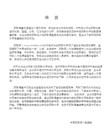
10 设计说明书(论文)质量 30 综述简练完整,有见解;立论正确,论述充分,结论严谨合理;实验正确,分析处理科学。
11 创新 10 对前人工作有改进或突破,或有独特见解。
成绩
指导教师评语
指导教师签名: 年 月 日
摘要及关键字
本程序中的数据采用“树形结构”作为其数据结构。具体采用的是“二叉排序树”。
1.2.5 平衡二叉树( AVL树 )
①平衡二叉树(Balanced Binary Tree)是指树中任一结点的左右子树的高度大致相同。 ②任一结点的左右子树的高度均相同(如满二叉树),则二叉树是完全平衡的。通常,只要二叉树的高度为O(1gn),就可看作是平衡的。 ③平衡的二叉排序树指满足BST性质的平衡二叉树。 ④AVL树中任一结点的左、右子树的高度之差的绝对值不超过1。在最坏情况下,n个结点的AVL树的高度约为1.44lgn。而完全平衡的二叉树高度约为lgn,AVL树是最接近最优的。
1.2.4平均查找长度…………………………………………………………… 6
1.2.5平均二叉树(AVL树)…………………………………………………… 6
1.2.6平衡因子………………………………………………………………… 7
1.2.7平衡二叉树的调整方法…………………………………………………… 7
攀枝花学院本科学生课程设计任务书
题 目 二叉排序树与平衡二叉树的实现
1、课程设计的目的
使学生进一步理解和掌握课堂上所学各种基本抽象数据类型的逻辑结构、存储结构和操作实现算法,以及它们在程序中的使用方法。
使学生掌握软件设计的基本内容和设计方法,并培养学生进行规范化软件设计的能力。
3) 使学生掌握使用各种计算机资料和有关参考资料,提高学生进行程序设计的基本能力。
二叉树的操作实验报告

二叉树的操作实验报告
实验报告:二叉树的操作
引言:
二叉树是计算机科学中最基础、最重要的数据结构之一,它不仅在算法设计与分析中被广泛应用,而且也在计算机系统和软件工程领域被广泛使用。
在这次实验中,我们将学习和实现二叉树的基本操作,包括二叉树的建立、遍历、查找和删除等。
实验过程:
1. 二叉树的建立
2. 二叉树的遍历
3. 二叉树的查找
4. 二叉树的删除
实验结果:
1. 建立一颗二叉树,根节点为A,左子树B,右子树C,B的左子树D,右子树E,C的左子树F,右子树G。
结构如下:
A
/ \
B C
/ \ / \
D E F G
2. 对上述二叉树先进行中序遍历:DBEAFCG,再进行前序遍历:ABDECFG,最后进行后序遍历:DEBFGCA。
3. 在上述二叉树中查找元素G,并输出其父节点元素C。
4. 删除上述二叉树中的元素F,再对其进行中序遍历,结果为DBEACG。
结论:
通过这次实验,我们掌握了二叉树的基本操作方法,对于理解和分析算法、编写系统和软件工程都具有重要的意义。
同时,在实践中我们也深刻地认识到了二叉树操作的复杂性和局限性,这需要我们在实际应用中加以考虑和综合利用,才能发挥其最大的价值和作用。
平衡二叉树的旋转操作

平衡二叉树的旋转操作平衡二叉树(AVL树)是一种自平衡的二叉搜索树,它的左子树和右子树的高度差(平衡因子)最多为1。
当插入或删除操作导致树的平衡被破坏时,需要进行旋转操作来恢复平衡。
本文将介绍平衡二叉树的旋转操作以及其实现原理。
1. 左旋操作左旋操作是一种将树向左偏移的操作,它可以用来处理右子树高度过高的情况。
具体步骤如下:(1). 将当前节点的右子节点作为新的根节点。
(2). 将新的根节点的左子节点作为当前节点的右子节点。
(3). 将当前节点作为新的根节点的左子节点。
左旋操作示意图如下:A B/ \ / \T1 B ---> A T3/ \ / \T2 T3 T1 T2在这个示例中,节点A的右子树过高,通过左旋操作将节点B作为新的根节点,节点A成为节点B的左子节点,节点T2成为节点A的右子节点。
2. 右旋操作右旋操作是一种将树向右偏移的操作,它可以用来处理左子树高度过高的情况。
具体步骤如下:(1). 将当前节点的左子节点作为新的根节点。
(2). 将新的根节点的右子节点作为当前节点的左子节点。
(3). 将当前节点作为新的根节点的右子节点。
右旋操作示意图如下:A C/ \ / \C T1 ---> T3 A/ \ / \T3 T2 T2 T1在这个示例中,节点A的左子树过高,通过右旋操作将节点C作为新的根节点,节点A成为节点C的右子节点,节点T2成为节点A的左子节点。
3. 左右旋和右左旋操作有时候仅通过单次旋转操作无法恢复平衡,需要进行左右旋或右左旋操作。
左右旋操作是先对当前节点的左子节点进行左旋,再对当前节点进行右旋。
右左旋操作是先对当前节点的右子节点进行右旋,再对当前节点进行左旋。
左右旋和右左旋操作的示意图如下:左右旋操作:A A C/ \ / \ / \B T4 --->C T4 ---> B A/ \ / \ / \ / \T1 C B T3 T1 T2 T3 T4/ \ / \T2 T3 T1 T2右左旋操作:A A B/ \ / \ / \T1 B ---> T1 C ---> A C/ \ / \ / \ / \C T4 T2 B T1 T2 T3 T4/ \ / \T2 T3 T3 T4通过左右旋和右左旋操作可以处理各种情况下的树平衡问题。
数据结构实验三——二叉树基本操作及运算实验报告
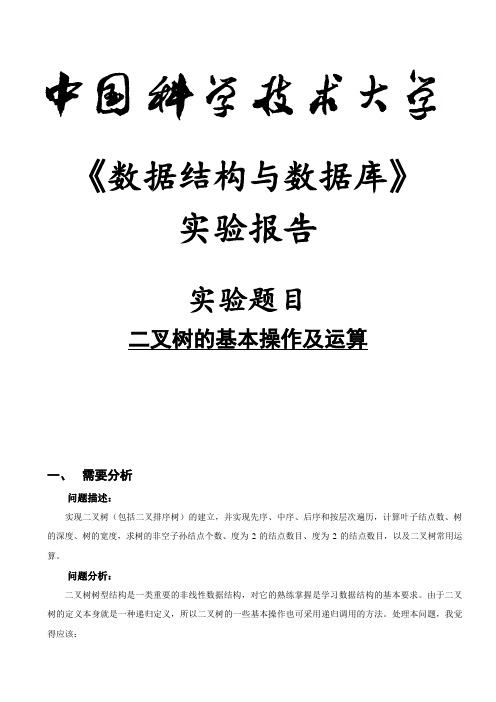
《数据结构与数据库》实验报告实验题目二叉树的基本操作及运算一、需要分析问题描述:实现二叉树(包括二叉排序树)的建立,并实现先序、中序、后序和按层次遍历,计算叶子结点数、树的深度、树的宽度,求树的非空子孙结点个数、度为2的结点数目、度为2的结点数目,以及二叉树常用运算。
问题分析:二叉树树型结构是一类重要的非线性数据结构,对它的熟练掌握是学习数据结构的基本要求。
由于二叉树的定义本身就是一种递归定义,所以二叉树的一些基本操作也可采用递归调用的方法。
处理本问题,我觉得应该:1、建立二叉树;2、通过递归方法来遍历(先序、中序和后序)二叉树;3、通过队列应用来实现对二叉树的层次遍历;4、借用递归方法对二叉树进行一些基本操作,如:求叶子数、树的深度宽度等;5、运用广义表对二叉树进行广义表形式的打印。
算法规定:输入形式:为了方便操作,规定二叉树的元素类型都为字符型,允许各种字符类型的输入,没有元素的结点以空格输入表示,并且本实验是以先序顺序输入的。
输出形式:通过先序、中序和后序遍历的方法对树的各字符型元素进行遍历打印,再以广义表形式进行打印。
对二叉树的一些运算结果以整型输出。
程序功能:实现对二叉树的先序、中序和后序遍历,层次遍历。
计算叶子结点数、树的深度、树的宽度,求树的非空子孙结点个数、度为2的结点数目、度为2的结点数目。
对二叉树的某个元素进行查找,对二叉树的某个结点进行删除。
测试数据:输入一:ABC□□DE□G□□F□□□(以□表示空格),查找5,删除E预测结果:先序遍历ABCDEGF中序遍历CBEGDFA后序遍历CGEFDBA层次遍历ABCDEFG广义表打印A(B(C,D(E(,G),F)))叶子数3 深度5 宽度2 非空子孙数6 度为2的数目2 度为1的数目2查找5,成功,查找的元素为E删除E后,以广义表形式打印A(B(C,D(,F)))输入二:ABD□□EH□□□CF□G□□□(以□表示空格),查找10,删除B预测结果:先序遍历ABDEHCFG中序遍历DBHEAGFC后序遍历DHEBGFCA层次遍历ABCDEFHG广义表打印A(B(D,E(H)),C(F(,G)))叶子数3 深度4 宽度3 非空子孙数7 度为2的数目2 度为1的数目3查找10,失败。
二叉排序树与文件操作的设计与实现

一、二叉排序树的基本概念二叉排序树又称为二叉查找树,是一种特殊的二叉树。
它的定义是:若左子树不空,则左子树上所有节点的值均小于它的根节点的值;若右子树不空,则右子树上所有节点的值均大于它的根节点的值;左、右子树也分别为二叉排序树。
二叉排序树的中序遍历结果是递增的。
二、二叉排序树的操作1. 查找操作在二叉排序树中查找一个值为key的节点时,可以按照以下步骤进行:1)若树为空,则查找失败;2)若树的根节点值等于key,则查找成功;3)若key小于树的根节点值,则在左子树中递归查找;4)若key大于树的根节点值,则在右子树中递归查找。
2. 插入操作插入一个新节点时,需要按照以下步骤进行:1)若树为空,则将新节点直接插入为根节点;2)若key小于树的根节点值,则将新节点插入到左子树中;3)若key大于树的根节点值,则将新节点插入到右子树中。
3. 删除操作删除一个值为key的节点时,需要考虑以下几种情况:1)若待删除节点无子节点,则直接删除;2)若待删除节点只有一个子节点,则将子节点替换为该节点;3)若待删除节点有两个子节点,则需要找到它的前驱或后继节点来替换。
三、文件操作的设计与实现1. 文件操作的基本概念文件操作是指对计算机文件进行的各种处理操作,包括创建、打开、读取、写入、关闭等。
在实际开发中,文件操作是非常常见的操作之一。
2. 文件操作的流程在进行文件操作时,一般需要按照以下流程进行:1)打开文件:通过指定文件名和打开方式,打开要进行操作的文件;2)读取或写入数据:根据需要进行读取或写入文件的操作;3)关闭文件:在操作完成后,需要关闭文件,释放资源。
3. 文件操作的设计与实现在进行文件操作的设计与实现时,需要考虑以下几点:1)文件存在性检查:在进行打开操作前,需要对文件是否存在进行检查,避免因文件不存在而导致的错误;2)错误处理:在进行文件操作时,需要对可能发生的错误进行处理,保证程序的稳定性和健壮性;3)资源释放:在操作完成后,需要及时关闭文件,并释放相关资源,以避免资源泄露。
- 1、下载文档前请自行甄别文档内容的完整性,平台不提供额外的编辑、内容补充、找答案等附加服务。
- 2、"仅部分预览"的文档,不可在线预览部分如存在完整性等问题,可反馈申请退款(可完整预览的文档不适用该条件!)。
- 3、如文档侵犯您的权益,请联系客服反馈,我们会尽快为您处理(人工客服工作时间:9:00-18:30)。
二叉树操作的实现
实验目的与要求:
1.基础知识:掌握数据结构中二叉树的相关知识;掌握C或VC++语言中程序设计的方法.
2.参考教材相关算法,完成以下程序功能:
(1) 能够采用二叉链存储,并实现二叉树的建立;
(2)完成已建立的二叉树的三种遍历;
(3)完成二叉树中特定结点的统计,如0元素结点或叶子结点统计; (4)程序中有友好的操作设计. 实验性质:验证性(2学时)
说明:程序包含主要函数:主函数、操作界面、建树、独立的三种遍历、特定结点统计、相关注释,注意在主函数流程中体现先建树后遍历和特定结点统计的条件
#include<stdio.h>
#include<stdlib.h>
struct node
{
char data;
struct node *lchild,*rchild;
} ;
int j=0;
int *g=&j;
void shuru(node*&t,char sn[50])
{
char ch;
ch=sn[j++];
if(ch=='@')
printf("输入的二叉树有误建树失败\n"); else if(ch=='#')t=NULL;
else
{ t=(node*)malloc(sizeof(node));
t->data=ch;
shuru(t->lchild,sn);
shuru(t->rchild,sn);
}}
void xianxu(node*&t)
{
if(t!=NULL)
{
printf("%c",t->data); xianxu(t->lchild); xianxu(t->rchild); }}
void zhongxu(node*&t) {
if(t!=NULL)
{
zhongxu(t->lchild); printf("%c",t->data); zhongxu(t->rchild); }}
void houxu(node *&t) {
if(t!=NULL)
{
houxu(t->lchild);
houxu(t->rchild);
printf("%c",t->data);
}}
int n;
int*h=&n;
void tongji(node*t)
{
if(t->lchild!=NULL||t->rchild!=NULL) {
if(t->lchild!=NULL)
tongji(t->lchild);
if(t->rchild!=NULL)
tongji(t->rchild);
}
else
n=n+1;
}
int main()
{
node *t;
t=(node*)malloc(sizeof(node));
char sn[50]={'#'};
int m,sal=1,i;
printf("----------------------------------------------------------------\n");
printf("\t本程序为建立二叉树和操作的实现\n");
printf("\t输入你要选择的操作\n");
printf("\t输入1为先序遍历二叉树\n");
printf("\t输入2为中序遍历二叉树\n");
printf("\t输入3为后序遍历二叉树\n");
printf("\t输入4为输出二叉树叶子节点的个数\n");
printf("\t输入5为结束\n");
printf("----------------------------------------------------------------\n");
do{
printf("按先序输入二叉树的元素‘#’为空以‘@’为结束标
志:\n");i=1;*g=0;
fflush(stdin);
scanf("%c",&sn[0]);
while(sn[i-1]!='@')
scanf("%c",&sn[i++]);
shuru(t,sn); } while(sn[*g-1]=='@');
while(sal)
{
printf("\t输入要选择的操作\n");
scanf("%d",&m);
if(m>5||m<1){printf("\t输入有误!请重新输入\n");}
switch(m)
{
case 1:printf("先序遍历二叉树为:");
xianxu(t);
printf("\n");break;
case 2:printf("中序序遍历二叉树为:"); zhongxu(t);
printf("\n");break;
case 3:printf("后序遍历二叉树为:"); houxu(t);
printf("\n");break;
case 4:*h=0;tongji(t);
printf("叶子节点个数为:%d\n",n); break;
case 5:printf("结束\n");
sal=0;break;
} }
return 0;
}。
